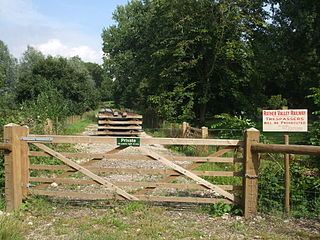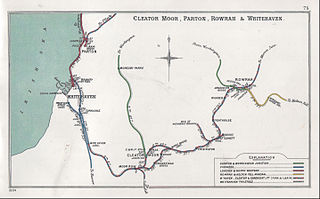
Swale railway station is in north Kent, England, on the Sheerness Line 47 miles 15 chains (75.9 km) from London Victoria, at the southern end of the Kingsferry Bridge which, along with the more modern Sheppey Crossing, connects the Isle of Sheppey to mainland Kent. The nearest settlement is Iwade. Train services are provided by Southeastern.

New Hythe railway station is on the Medway Valley Line in Kent, England, serving the village of New Hythe. It is 38 miles 3 chains (61.2 km) down the line from London Charing Cross via Strood and is situated between Snodland and Aylesford. The station and all trains that serve the station are operated by Southeastern.

Five Mile House was a railway station on the Lincolnshire Loop Line which served the village of Fiskerton in Lincolnshire between 1848 and 1964. Situated on the south bank of the River Witham, passengers on the north bank had to use a ferry to reach it. It closed two years after opening due to low traffic, but reopened fifteen years later. Withdrawal of passenger services took place in 1958, leaving the station open for anglers' excursions until 1964. The Water Rail Way footpath now runs through the site.

Ampress Works Halt was a halt station on the Lymington Branch Line which, between 1956 and 1989, served the Wellworthy engineering works near Lymington in Hampshire, England. Sited near the bridge over the A337 Lymington to Brockenhurst road, the station closed when the engineering works ceased operation. The station never appeared in any public timetable.
Woodend railway station was planned by the Whitehaven, Cleator and Egremont Railway on its Sellafield to Moor Row branch, but by the time the station opened the company had been bought out by the LNWR and Furness Railway who operated the line jointly until grouping in 1923.

Great Broughton railway station briefly served the village of Great Broughton, near Cockermouth in Cumberland, England.
Cardington Workmen's Platform was a railway station on the Bedford to Hitchin Line which served the Royal Air Force station near the village of Cardington in Bedfordshire, England. A short-lived halt, it opened during the First World War and closed in 1921.

Shakespeare Cliff Halt is a private halt station on the South Eastern Main Line. It is located to the western end of the dual bore Shakespeare Cliff tunnel on the South Eastern Main Line to Folkestone, England. It never appeared in any public timetable and has been used successively by railway staff, coal miners, the military and Channel Tunnel workers.

Junction Road Halt, also known as Junction Road , was a halt station on the Kent and East Sussex Railway. It was located on the eastern side of the level crossing across the B2244 Junction Road near the hamlet of Udiam in East Sussex, England. Closed for passengers in 1954 and freight in 1961 with the line, The line through Junction Road Halt may yet be revived as the Rother Valley Railway, a preservation society, is proposing to reopen the line from Robertsbridge to Bodiam.

Island Road railway station was a railway station at the centre of Barrow Island, Barrow-in-Furness, England which operated between 1899 and 1967. It was built by the Furness Railway near the junction of the Ramsden Branch Line and a line which ran through the industrial areas of the town.

Ulceby Aerodrome Platform railway station was situated 74 chains (1.5 km) northeast of Ulceby North Junction between Ulceby and the village of South Killingholme, Lincolnshire, England. It was opened by LNER to serve the Second World War airfield RAF North Killingholme, whose southern perimeter lay a short distance to the north.

Park Lane Halt railway station was an unadvertised halt which served the communities of Bickershaw and Abram southeast of Wigan, England.

Winder railway station was built by the Whitehaven, Cleator and Egremont Railway. It served the village of Winder, Frizington, Cumbria, England.

Frizington railway station was built by the Whitehaven, Cleator and Egremont Railway. It served the industrial Parkside area of Frizington, Cumbria, England.
Egremont railway station was built by the Whitehaven, Cleator and Egremont Railway as the first southern terminus of what would become the Moor Row to Sellafield branch. In 1878 the company was bought out by the LNWR and Furness Railway who operated the line jointly until grouping in 1923.
St Thomas Cross Platform was a railway station used by workmen's trains on the Moor Row to Sellafield line on what is now the southeastern, Cringlethwaite, edge of Egremont, Cumbria, England.
Beckermet Mines railway station was situated at Pit No.1 of the mine of the same name. It was used by workmen's trains which travelled along a branch which curved eastwards off the Moor Row to Sellafield line, primarily to handle the iron ore lifted at the site.

Buckhill Colliery Halt railway station was an unadvertised halt for workers at Buckhill Colliery north east of Camerton, near Cockermouth in Cumberland, England.
Rose Hill Platform served workmen in the Rose Hill area of Harrington in the former county of Cumberland, England, which is now part of Cumbria.
Allhallows Colliery railway station was in the former county of Cumberland, now Cumbria, England. It was a stop on the Bolton Loop of the Maryport and Carlisle Railway.